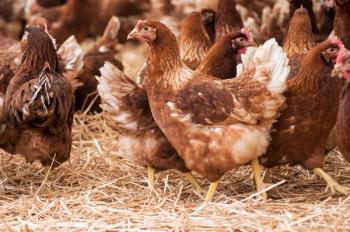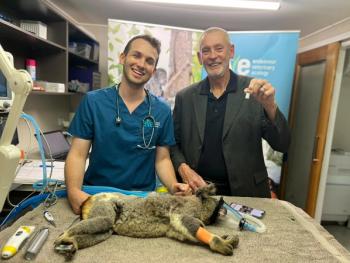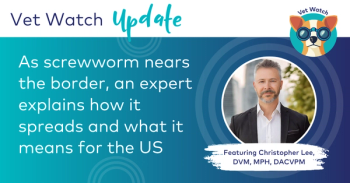
Treating feline cryptococcosis (Proceedings)
Cryptococcus neoformans is a saprophytic round yeast-like fungus with the ability to form a heteropolysaccharide capsule in tissues.
Etiology
- Cryptococcus neoformans: saprophytic round yeast-like fungus with the ability to form a heteropolysaccharide capsule in tissues.
- Is the only cryptococcal spp that can grow at 37°C so it's the only one that infects vertebrates.
- Not a true yeast but related to rust and smut fungi.
- Reproduces by budding. Yeast phase is also found in laboratory culture.
Epidemiology
- Found mainly in excrement (high nitrogen) - bird housing etc.
- Organisms pass through the GIT of pigeons, and remain viable in droppings for up to 2 yrs.
- Worldwide distribution. It mainly infects cats, although can infect dogs and other mammals.
Pathogenesis
- Exact mode of infection is unknown although inhalation most likely.
- After infection, organisms may:
o deposit on nasal epithelium → nasal granuloma
o reach alveoli → pulmonary granuloma
- Dissemination may occur from the respiratory tract usually to the CNS by local spread through the cribiform plate or blood.
- Dissemination depends on immune status. Other condition causing immunosuppression is present in animals with CNS disease such as corticosteroid therapy, FIV, FELV.
Clinical Findings
- Most common systemic mycosis in cats
- No sex, age, breed predisposition.
- Upper respiratory tract signs are the most common:- sneezing, snuffling, mucopurulent nasal discharge, but few other systemic signs. Some present with signs referable to nasopharyngeal mass lesions (snoring, stertor, inspiratory dyspnea) that are not obvious on clinical examination (best diagnosed by caudal rhinoscopy and vigorous orthograde flushing with saline to obtain cytologic material).
- Flesh colored masses in nostril or a firm swelling over the nose seen in ~ 70% of cases.
- Submandibular lymphadenopathy usually seen.
- Sometimes see ulcers in mouth.
- Lower respiratory tract signs are rare.
- Cutaneous lesions occur in about 40% of cases. May only be small nodules 1 to 10 mm.
- CNS signs variable (depend on the location of lesions). Cranial nerve involvement is common.
- Ocular disease seen often in cats with CNS disease. Main signs are blindness, due to exudative retinal detachment, granulomatous chorioretinitis, panophthalmitis, anterior uveitis.
Diagnosis
Cytology
- Most rapid method of definitive diagnosis.
- Examine nasal or skin exudate, CSF, tissue aspirates or ocular samples.
- NMB and Gram's stains are the best although Wrights stain will suffice.
Serology
- Latex agglutination (detect cryptococcal capsular antigen) only clinical applicable test.
o Detects antigen in serum, CSF, or urine.
o Its use is well documented in cats.
o Can be used to prognose the efficacy of therapy i.e. Favorable prognosis when get a 10-fold drop in titer at the end of 2 months treatment (see treatment).
o Can get small false positive results (1:8) from latex contacting the sample during collection (latex gloves and stopper of collection tube for CSF samples – use plastic wrap to prevent contact of sample with stopper).
o CSF cryptococcosis virtually always produces a positive serum titer.
o No correlation between size of pretreatment titer and outcome.
Tissue Biopsy
- Impression smears from biopsied tissues can often give a quick diagnosis.
- PAS, methenamine silver, or Masson-Fontana stains are best although H&E is OK.
Culture/Isolation
- Culture is easy from exudates, aspirates, urine, joint fluid, tissue samples.
- Use Sabouraud's agar with antibiotics added.
Therapy
- Mass lesions, may need surgical debulking (via endoscope for rhinopharyngeal lesions) to alleviate inspiratory dyspnea, and then the administration of systemic anti-fungal therapy.
- Antifungal therapy is mainstay of therapy.
- Most use itraconazole in non-ocular or central nervous system cases. Fluconazole is used in CNS or ocular cases (as it crosses the blood/brain barrier). Amphotericin B used in cases that can't afford conazoles (can use it subcutaneously also), or if want a rapid improvement.
- Patients that respond well to treatment have a progressive decline in latex agglutination titer, but the titer tends to lag behind clinical improvement. Generally, titers decline by 2 to 4 fold/mth during successful Tx
- Cats that don't respond show unchanged (or even increased) antigen titers even when treatment lasts for 6 months.
- It is recommended to continue treatment until the LCAT titer has become negative, or at least after a 32 fold (or higher) reduction.
Drugs of Choice
- Itraconazole (Sporanox® - Janssen) – first choice in cases without ocular or neurologic involvement as does not penetrate into these tissues; less expensive than fluconazole (NO LONGER THE CASE!); give with fatty food (such as canned) to improve absorption. [Dose: 10-15 mg/kg, PO, q24h for 6-10 months.]
- Fluconazole (Diflucan® - Pfizer) – first choice in cases with ocular or neurologic involvement as does penetrate into these tissues. [Dose: 5-15 mg/kg, PO, q24h for 6-10 months.]
- Flucytosine (Ancobon® - Roche) – best if used with trizoles (itraconazole or fluconazole) or Amphotericin B when infection not responding well to single agent. [Dose: 30 mg/kg, PO, q8h for 6-10 months.]
- Amphotericin B – deoxycholate (Fungizone® - Squibb) – stated to be the most effective anticryptococcal agent; only drug that is cidal and permenantly eradicate CNS infections (even though doesn't cross a normal blood brain barrier; use if other therapies too expensive; most successful therapeutic regimen known when used with flucytosine for severe and widely disseminated disease (e.g. CNS disease); administer in conjunction with fluid therapy to protect against nephrotoxicity; heat pre-treatment (60o to 70oC, 10 minutes to form superaggregation) immediately before use markedly reduces nephrotoxicity; using SC in cats will reduce toxicity; monitor renal toxicity by examining urine for casts (most sensitive) or measuring serum urea; fluid diuresis and furosamide administration limit nephrotoxicity in dogs (mannitol, sodium bicarbonate or dopamine do not). [Dose: 0.5-0.8 mg/kg, SC, 3x/week up to total cumulative dose of 8-26 mg/kg – higher than if given IV (up to 12 mg/kg).]
- Method of SC amphotericin B administration: add each dose to 400 ml of 0.45% saline, 2.5% dextrose; concentrations > 20 mg/L are irritating and can cause SC abscesses.
- Terbinifine (Lamisil® - Sandoz) – effective in cats with resistant infections to the triazoles; expensive. [Dose: 5-10 mg/kg, PO, q24h for 1-3 months.]
Prevention
- Restrict access of cats to bird droppings etc.
- Can reduce organism contamination in pigeon lofts by using hydrated lime diluted in water 40 gm/liter (1 lb/3 gal) plus 1.5 gm/liter of NaOH. Apply at a rate of 1.36 L/m3.
Public Health Consideration
- Culture of Cryptococcus in the lab is not hazardous to workers as only the yeast form is grown and it does not aerosolize.
- Contact with infected pets is also not a risk to owners.
- Source of exposure is the main health risk to owners.
References
Malik R, Krockenberger M, O'Brien CR, et al. Cryptococcosis. In: Infectious Diseases of the Dog and Cat (3rd ed). Greene CE (ed), WB Saunders, Philadelphia, 2006, 584-598.
O'Brien CR, Krockenberger MB, Wigney DI, et al. Retrospective study of feline and canine cryptococcosis in Australia from 1981 to 2001: 195 cases. Med Mycol 42:449-460, 2004.
Newsletter
From exam room tips to practice management insights, get trusted veterinary news delivered straight to your inbox—subscribe to dvm360.






